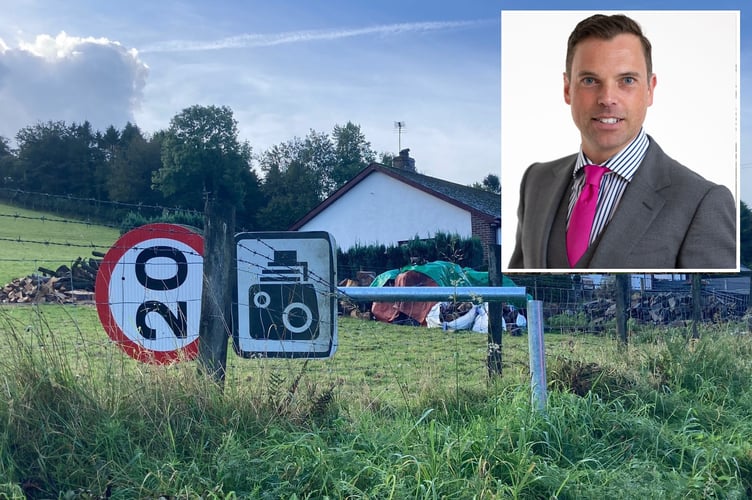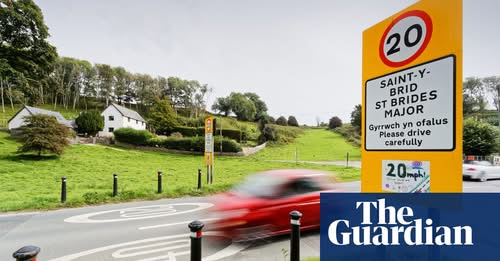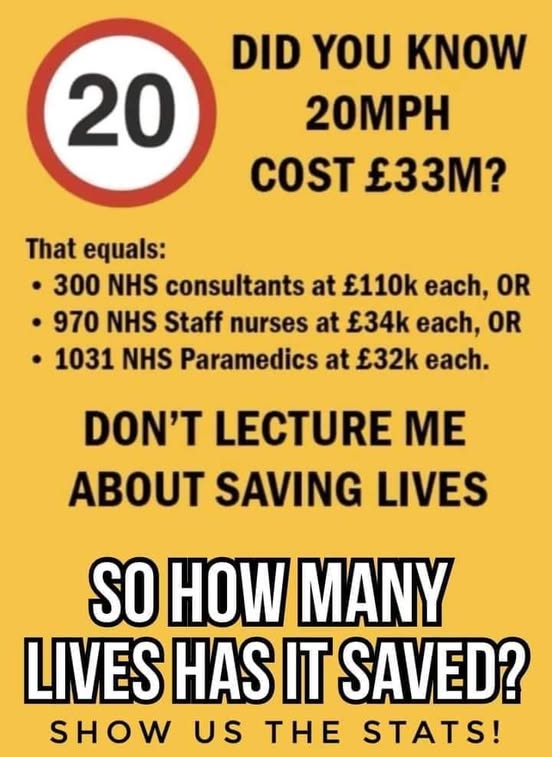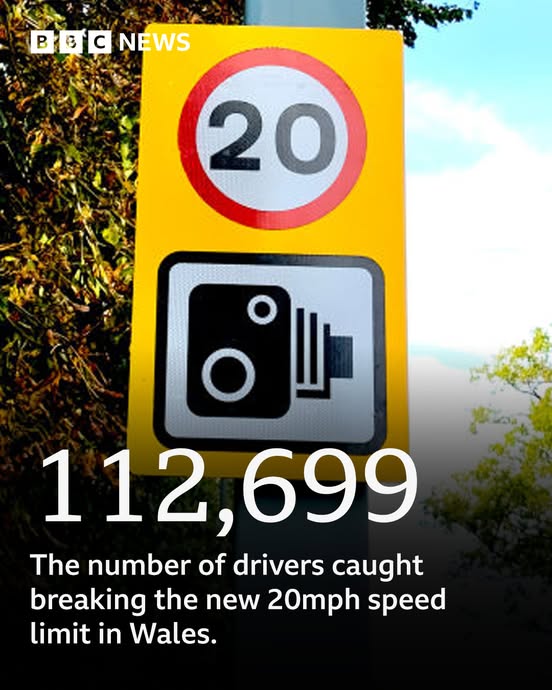Twenty MPH Reporting In The Lead Up To The Senedd Election
In early 2025, in the lead up to the 2026 election campaign period, articles began to appear in local and national media in Wales extolling the success of the Blanket 20mph scheme.
The Monmouthshire Beacon for example ran a story on 30/1/25 by its reporter Chris Betteley with the following headline:
“100 Fewer People Killed Or Seriously Injured
Since 20mph Speed Limits introduced” 1

The article featured the above picture of Lee Waters who when Transport Minister had introduced the 20mph scheme. His picture was superimposed on a 20mph speed limit sign that someone had chopped down.
Using data supplied to the newspaper but not published in the article, Ken Skates, the Transport Minister who replaced Waters was reported as claiming that:
“the data showing fewer collisions, deaths and injuries is ‘encouraging’.”
The article went on to make the spectacular claim that:
“Collisions are at their lowest level since records began, and 100 fewer people have been killed or seriously injured on Welsh roads since the introduction of a default 20mph speed limit compared to the previous year, fresh figures show”.
In our tab “Lies, Damn Lies and Statistcs” (Allied Issues stack) we pointed out the difficulties of taking anything claimed in a newspaper headline at face value when the actual data has not been published and opened up to scrutiny. We have therefore requested that the data seen by the paper be made available to us to subject it to statistical analysis. We await their response.
We note here that these claims were made on the basis of a short run on data since the scheme was only initiated in September 2023 and ideally at least five years worth of date should be used before making any claims as bold as the one made above.
We also noted that there were may ways of looking at data and that assessing the success or otherwise of the blanket 20mph scheme which has proved deeply unpopular with very many people must be done on the basis of both quantitative and qualitative considerations.
The following reader comments were printed at the end of the article reflecting a healthy scepticism and giving a flavour of peoples’ concerns:
“I think the statistics need expert analysis from a transport group to put this into context. The mid term statistics showed reductions across the board and the institute of vehicle insurers confirmed that the main effect had been as a result of milder weather making driving conditions easier. Ken Skates is a politician who has a vested interest. The lower blanket speed limit was meant to ease pressure on the NHS in Wales, there is no evidence of that based on the latest performance data”
“You can manipulate the figures in anyway you can to achieve the result your looking for, we are not stupid. What is more shocking is the amount of money wasted, firstly by the carpet default 20 limit being imposed and another mountain of cash wasted removing them”
“The key question is what the reduction in death rates in 20mph roads. Unless you are saying that introducing a 20mph limit has had the effect of reducing death rates in 30, 40, 50 and 70mph speed limit roads as well”.
Possible Displacement Effects
The following observation was made in a social media post recently:
“Since this 20mph blanket I see everyday more and more accidents. Im sure more people use these roads to keep away from slower now congested roads”.

Commenting on possible displacement effects, Brian Gregory, Founder and Policy Director of The Alliance of British Drivers / Driving Sense had this to say:
“In making the case for blanket 20mph zones, pro-20mph so-called “safety” campaigners invariably cite raw casualty figures quoted in isolation. These reduction claims are seldom assessed in comparison with safety trends on a statistically valid basket of adjacent roads which have not been subject to the reduction in speed limit.
Further, raw casualty figures should be NEVER be used to make decisions. All decisions should be made using normalised figures: i.e., in casualties – deaths & serious injuries – per Billion vehicle miles (BnVm) or Billion vehicle kilometres (BnVkm); which effectively negates the effects of changes in traffic volumes.
Let’s be very clear: a traffic measure that allegedly reduces casualties on a given stretch of road by 10%, 20% or whatever; but achieves this by displacing 50% of the traffic normally using that road onto adjacent ones where the speed restriction doesn’t apply, has potentially made local road safety worse, not better.
This applies not just to 20mph zones, but equally to lowering speed limits in general”.
>> work in progress below here
That Guardian Article!

On 22/3/25 Peter Walker of The Guardian newspaper ran an article headined
“Wales’s 20mph Speed Limit Has Cut Road Deaths.
Why Is There Still Even A Debate?”1
The article sought to pre-emptively silence anybody who might still have legitimate concerns about the 20mph policy exactly as Guardian Correspondent George Monbiot had tried to do when challenging Paul Smith of Safespeed in the early part of the century
This article begain with the following disclaimer:
“Even with the caveats about limited data and untangling causation and correlation, the statistics are striking: the first year of a scheme in Wales where the speed limit on urban roads was lowered to 20mph resulted in about 100 fewer people killed or seriously injured.”
In making this statement The Guardian in effect was seeking to cover itself for the deceit it was about to practice. A more honest way of putting this would have been for it to say:
“The Welsh Government claims that 100 fewer people have been killed or seriously injured since the speed limit on urban roads in Wales lowered to 20mph in the first year of its blankett 20mph scheme – a staggering 8.3 people for every month. Caution must be exercised in interpreting this striking claim however since it is based on limited data and no attempt has been made to untangle causation and correlation which could lead to completely different conclusions being reached.”
In the article Professor Ian Walker, a Professor or environment psychology at Swansea Univerity tried to push the idea that policies such as 20mph zones are often more peopular than people think. It comes as no surprise that Professor Walker should claim that consultations tend to be dominated by dissent as he himself is an active travel activist!
Changing Definitions Of Serious Injury To Suit The Argument
The Cost Of Alleged Success….

Conclusive Evidence That 20mph is An Unreasoanble Speed Limt – Over 100,000 Criminalised Drivers Cannot Be Wrong!

We believe that a fair and sensible road safety policy would stipulate that:
“The reasonable actions of a competent, responsible road user
should be considered legal”.
Instead, over 112,00 drivers, the majority of whom would have been competent and responsible have been criminalised here by the authoritarian Welsh Labour Government. Shame on them, easpecially at a time when drivers are having to content with a severe cost of living crisis.
In terms of data therefore, it would be interesting to see the distribution of speeds above 20mph at which these 112,699 drivers were traveling to be able to analyse them in terms of the 85th Percentile Principles at which spped limits should be set.
If that statistical exercise were done then clearly a large number, perhaps the majority, of these drivers might have a right to claim a refund for their fines in a class action because the speed limit and enforcement threshold were wrongly set.
The Cost To Drivers’ Mental HealthOf Receiving a Notice Of Intended Prosecution Through The Post.
When police road traffic officers patrolled to roads, drivers of interest to them were dealt with there and then at the roadside
>>>> to complete
Were The Figures Quoted In The Guardian Real Or Hypothetical?
“TRL reports like 421 and 511 hypothesise that a 1 mph reduction in average traffic speed leads to a 5% reduction in accidents. These claims arise from limited desktop modelling studies; not from practical road safety assessments or records.
Real-life speed limit reductions seldom (if ever) deliver either the traffic speed or casualty reductions alleged in the two TRL reports.
The 5% / 1mph assertion is an exercise in “reductio ad absurdum”: suggesting, for example that a 21mph average traffic speed reduction would result in 5% of road accident fatalities being resurrected……
Although hailed as road safety gospel by the current establishment and its vested interest lobbyist supporters, the assumptions TRL researchers made in reaching the 5% / 1mph assertion, and which therefore underpin it, are very comprehensively discredited by the the late Paul Smith of Safespeed here:
http://www.safespeed.org.uk/trl421.html
As a practical supporting evidence, in 2018 the speed limit on all French rural single-carriageway route nationale roads was reduced from 90kph to 80kph. This did not significantly reduce casualities. What it did do was significantly hobble the French rural economy – to the tune of c.4.4Bn€ per annum; economic cost-benefit analysis seldom being an issue addressed in any speed limit change proposals.
From 2019 onwards there was growing rural area public opposition to 80kph. By 2022 the French government was forced to respond to it and gave dispensation for départements to decide locally whether to retain 80kph or revert to 90kph; the latter being the course of action since adopted by many of them.”
Conclusions
Propaganda in the lead up to an election?
Articles supported by those with a vested interest in the scheme being deemed a success and continuing
or even if not propaganda, the cost benefit of the scheme is not made out….
References